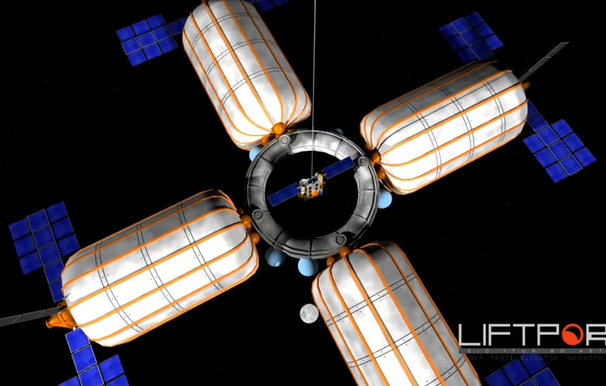Space Elevator Project Shoots for the Moon

A space elevator capable of shuttling robots or humans from the Earth to space remains decades away. But a company headed by a former NASA researcher says it can build a space elevator on the moon using today's technology.
The LiftPort Group wants to raise $8,000 on the crowd-funding website Kickstarter for its first step — creating a floating balloon platform tethered to the ground so that a robot can climb 1.2 miles (2 kilometers) into the sky. But the fundraiser also marks the return of a company that had closed during the 2007-2012 economic recession.
"About six months ago we had a fundamental breakthrough — a breakthrough we think will transform human civilization — and we want you to be a part of it," said Michael Laine, president of the LiftPort Group.
The breakthrough will allow the LiftPort group to build a space elevator on the moon using existing technology and a single-launch rocket solution that has "Sputnik-like simplicity," Laine said. He added that the concept could become a reality within eight years.
Staying down to Earth
A space elevator on the moon would face fewer complications than a space elevator on Earth because the moon has less gravity and practically no atmosphere — factors that would otherwise place great stress on whatever material makes up the space elevator's tether. [Quiz: Sci-Fi vs. Real Technology]
Laine worked on space elevator concepts with the NASA Institute for Advanced Concepts research team from 2001-2003. He went private with the LiftPort Group in 2003 and experimented with robots that climbed as high as 1 mile (1.6 kilometers) up a tethered balloon platform, before the company shut down.
Get the Space.com Newsletter
Breaking space news, the latest updates on rocket launches, skywatching events and more!
Such balloon platforms don't just help aim for the moon. They could also act as cheap communications "towers" on Earth to help provide wireless Internet, monitor crops, watch out for forest fires, or even carry cameras to provide an eye in the sky in the aftermath of natural disasters.

The newly resurrected LiftPort Group has set a relatively modest fundraising goal because it's still training a new group of volunteers. Many former LiftPort members have gone on to other projects — Tom Nugent, a former research director for LiftPort Group, co-founded a company called LaserMotive that has experimented with using lasers to power climbing robots and drones.
Laine also emphasized his vision of Kickstarter as being more important for gathering a community rather than simply raising money. He pointed out how most people contributing to the top Kickstarter projects contributed relatively little in terms of money, but instead brought their enthusiasm to the projects.
Aiming for the moon
Still, modest steps have not prevented the LiftPort Group from planning what to do in case it raises more than the $8,000 in its first Kickstarter project. Its list of "Stretch Goals" pegged at successively higher funding targets include adding more sensors and having the robot climb to almost 19 miles (30 kilometers) up.
The most ambitious goal of raising $3 million — a target Laine doesn't expect to hit in the first Kickstarter — would allow the LiftPort Group to carry out a one-year feasibility study for the moon space elevator project. But Laine did express the wish to hit a $100,000 target.
"If we 'only' hit $8,001, then we are going to remain a 'hobby' team," Laine said. "If we can hit this number, then LiftPort is a '…before this decade is out…' Lunar Elevator company!"
The LiftPort Group is not alone in its long-term space elevator quest. Seattle-based LaserMotive has previously won the Space Elevator Games, a NASA-sponsored contest. Across the Pacific, Japan's Obayashi Corp has set the goal of building a space elevator by 2050.
This story was provided by InnovationNewsDaily, a sister site to SPACE.com. Follow InnovationNewsDaily on Twitter @News_Innovation, or on Facebook.
Join our Space Forums to keep talking space on the latest missions, night sky and more! And if you have a news tip, correction or comment, let us know at: community@space.com.

Space.com is the premier source of space exploration, innovation and astronomy news, chronicling (and celebrating) humanity's ongoing expansion across the final frontier. Originally founded in 1999, Space.com is, and always has been, the passion of writers and editors who are space fans and also trained journalists. Our current news team consists of Editor-in-Chief Tariq Malik; Editor Hanneke Weitering, Senior Space Writer Mike Wall; Senior Writer Meghan Bartels; Senior Writer Chelsea Gohd, Senior Writer Tereza Pultarova and Staff Writer Alexander Cox, focusing on e-commerce. Senior Producer Steve Spaleta oversees our space videos, with Diana Whitcroft as our Social Media Editor.












